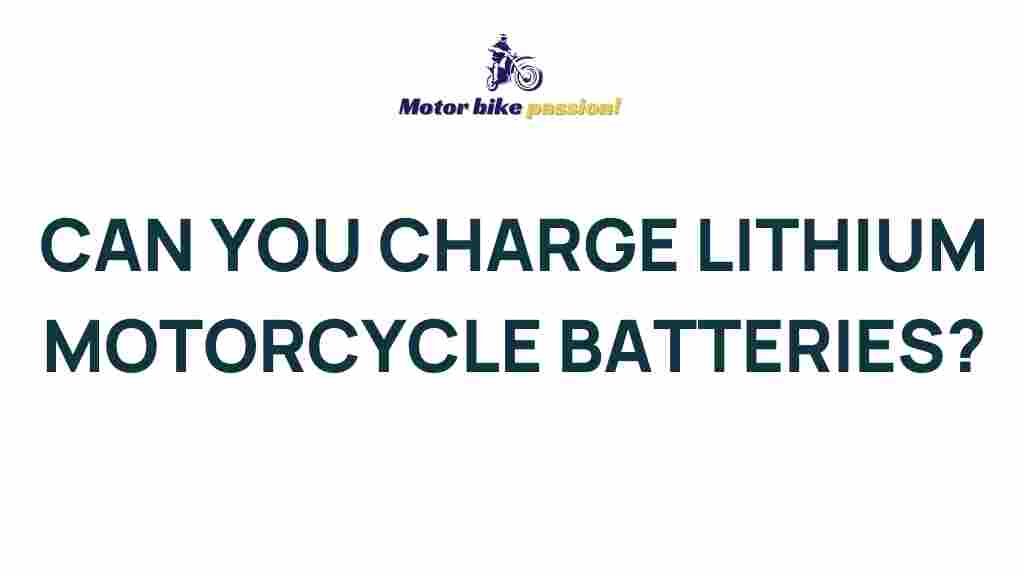Unveiling the Secrets of Charging Lithium Motorcycle Batteries
As motorcycle enthusiasts, we understand the importance of keeping our rides in top condition, and one crucial aspect of this is the maintenance of our lithium motorcycle batteries. Charging these batteries correctly is essential for ensuring their longevity, performance, and safety. In this article, we will explore the best practices for charging lithium motorcycle batteries, provide valuable tips for maintenance, and highlight important safety measures to maximize efficiency. Whether you’re a seasoned rider or a newcomer, this guide will equip you with the knowledge to charge your lithium motorcycle batteries effectively.
Understanding Lithium Motorcycle Batteries
Lithium motorcycle batteries have become increasingly popular due to their lightweight, high energy density, and longer lifespan compared to traditional lead-acid batteries. They offer several advantages, including:
- Weight Savings: Lithium batteries are significantly lighter, contributing to better handling and performance.
- Longer Life Span: With proper maintenance, lithium batteries can last up to 10 years.
- Faster Charging: They can be charged more quickly than lead-acid batteries.
- Higher Efficiency: Lithium batteries tend to have a higher charge retention, meaning they can hold a charge longer when not in use.
However, charging lithium motorcycle batteries requires specific attention to detail. Following the right procedures and practices can prevent damage and ensure optimal performance.
Step-by-Step Process for Charging Lithium Motorcycle Batteries
Charging lithium motorcycle batteries can be straightforward if you follow these best practices:
1. Gather Your Equipment
Before you begin, make sure you have the following items:
- Lithium-Compatible Charger: Ensure your charger is specifically designed for lithium batteries.
- Safety Gear: Always wear safety glasses and gloves when working with batteries.
- Multimeter: This will help you check the battery’s voltage.
2. Prepare the Battery
Before charging, inspect the battery for any signs of damage or corrosion. Ensure the terminals are clean and free of debris. If necessary, clean them with a mixture of baking soda and water.
3. Connect the Charger
Follow these steps when connecting the charger:
- Turn Off the Charger: Ensure the charger is turned off before connecting.
- Connect Positive Terminal First: Attach the red positive cable to the positive terminal of the battery.
- Connect Negative Terminal: Attach the black negative cable to the negative terminal of the battery.
4. Set the Charger
Set your charger to the correct voltage and amperage as specified by the battery manufacturer. Most lithium motorcycle batteries require a charging voltage of 14.4 to 14.6 volts.
5. Start Charging
Turn on the charger and monitor the charging process. Most modern chargers have indicators to show the charging status. Avoid overcharging, which can damage the battery.
6. Disconnect the Charger
Once fully charged, turn off the charger before disconnecting the cables:
- Remove Negative Terminal First: Disconnect the black negative cable first to prevent any spark.
- Remove Positive Terminal: Disconnect the red positive cable next.
7. Store the Battery Properly
If you won’t be using the motorcycle for an extended period, store the battery in a cool, dry place and maintain a charge of around 50% to prolong its life.
Tips for Maintaining Lithium Motorcycle Batteries
Proper maintenance of lithium motorcycle batteries is essential for ensuring their longevity and optimal performance. Here are some tips:
- Regularly Check Voltage: Use a multimeter to check the battery voltage regularly. It should remain above 12.8 volts when not in use.
- Keep Terminals Clean: Regularly clean the battery terminals to prevent corrosion.
- Charge Regularly: Lithium batteries should not be allowed to discharge completely. Charge them every few months if not in use.
- Avoid Extreme Temperatures: Store and use the battery in moderate conditions to prevent damage.
Troubleshooting Common Issues
Even with careful handling, issues can arise with lithium motorcycle batteries. Here are some common problems and their solutions:
1. Battery Not Charging
If your battery isn’t charging, check the following:
- Ensure the charger is functioning properly.
- Check all connections for tightness and cleanliness.
- Test the battery with a multimeter; it may need replacement if it shows significantly low voltage.
2. Battery Draining Quickly
If you notice your battery discharging faster than usual, consider these factors:
- Check for parasitic drains from accessories.
- Ensure the battery is not over five years old, as age can affect performance.
- Inspect for any signs of damage or swelling.
3. Overheating During Charging
If the battery overheats, this could indicate:
- An incorrect charger setting.
- A short circuit within the battery.
- Environmental factors; ensure it’s in a well-ventilated area.
Safety Precautions When Charging Lithium Motorcycle Batteries
Safety should always be your top priority when charging lithium motorcycle batteries. Here are some essential safety tips:
- Use a Quality Charger: Always opt for chargers specifically designed for lithium batteries to avoid hazards.
- Charge in a Safe Location: Avoid charging in enclosed spaces; ensure adequate ventilation.
- Monitor Charging: Never leave the battery unattended while charging.
- Be Aware of Temperature: Do not charge the battery in extreme heat or cold.
Enhancing Charging Efficiency
To maximize the efficiency of charging lithium motorcycle batteries, consider these practices:
- Optimal Charge Levels: Charge your battery to about 80-90% for regular use; this extends its life.
- Use Smart Chargers: Invest in smart chargers that automatically adjust to the battery’s needs.
- Regular Maintenance: Keeping the battery terminals clean and connections tight enhances efficiency.
Conclusion
Charging lithium motorcycle batteries is an essential skill for any rider looking to maintain their motorcycle’s performance and longevity. By following the best practices outlined in this guide, you can ensure that your battery remains in excellent condition, providing you with the power you need for every ride. Remember to prioritize safety and efficiency by using the correct equipment, maintaining your battery, and charging it properly. For further insights into battery care, you can visit this resource. Happy riding!
This article is in the category Maintenance Tips and created by MotorBikePassion Team
